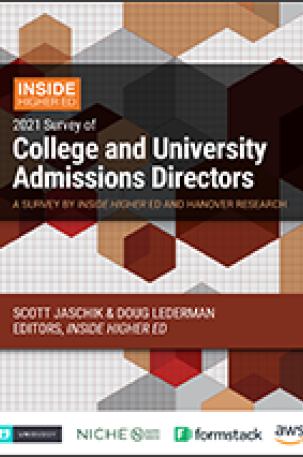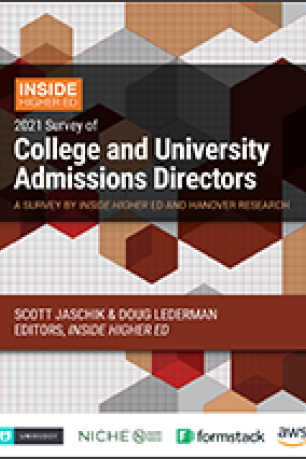Free Download

The 2020-21 year was a shock to the entire system of higher education. Admissions was hurt throughout, beginning as students were sent home and banned from campuses (before the 2020-21 year had even started), making it impossible for many students to see the campuses at which they would enroll. In the fall of 2020, many campuses remained closed to in-person instruction (and campus visits by prospective students). Even as some campuses started to reopen in the spring of 2021 and vaccines started to become available, many campuses were operating on anything but a normal schedule.
With all of these challenges, how did admissions fare? And how did that the challenges of the last year reshape the landscape for admissions? In our survey of 206 admissions officials, Inside Higher Ed found:
- Admissions officers were very worried about filling their classes this year and most did not fill their classes by the traditional May 1 date for the following fall’s class. Add in the months of May and June, and most admissions offices were still searching for students.
- Most campuses said that campus closures in the last academic year had hurt their efforts to recruit enough students. The interest in videos and online recruiting is expected to remain high.
- Despite various difficulties in recruiting, just under half of all admissions officers expect to enroll more students this fall than last.
- About one-third of admissions officers said that the pandemic did not change whom they admitted. Thirty-seven percent said it changed whom they admitted, but in a minor way.
- Over 95 percent of campuses used test-optional or test-blind admissions this year.
- Of those that adopted test-optional or test-blind admissions this year, 55 percent say they admitted more Black, Latinx and Native American students.
- Three-quarters of admissions officers favor continuing test optional indefinitely.
- More than 80 percent of officers say they are very likely to increase recruitment for minority and transfer students, while approximately three-quarters (78 percent) say the same for full-time undergraduates and first-generation college students. Comparatively, only a quarter (26 percent) say they are likely to increase recruitment efforts for part-time undergraduates. Only 38 percent of officials say they are likely to increase recruitment efforts for online students.
- Most are either not worried (40 percent) or only slightly worried (21 percent) about the prospect of the Supreme Court deciding to review Harvard University’s affirmative action plans.
The survey was conducted by Hanover Research in August.
Filling Their Classes
For years, Inside Higher Ed has asked admissions leaders about their attitudes for the year just concluded and if and when they filled their classes.
In terms of attitude, this year was one of extreme concern. Fifty-nine percent of respondents said they were "very concerned" about meeting their enrollment goals for the fall, and another 32 percent were "concerned." Only 5 percent were "not too concerned" and 4 percent were "not concerned at all."
About the Survey
Inside Higher Ed’s 2021 Survey of College and University Admissions Officers was conducted in conjunction with researchers from Hanover Research. Inside Higher Ed regularly surveys key higher ed professionals on a range of topics.
You may download a full survey report here.
On Wednesday, Oct. 20 at 2 p.m. Eastern, Inside Higher Ed will present a free webcast to discuss the results of the survey. Sign up here.
The Inside Higher Ed survey of admissions directors was made possible in part by support from AWS, Formstack, Niche and Unibuddy.
While the respondents were granted complete anonymity in their responses, they are consistent with what is happening this fall. For colleges that are highly competitive in admissions, it was a good year in admissions.
As in years past, we asked if colleges met their enrollment goals for new students by May 1, the traditional date to respond to an offer of admission. Only 32 percent of colleges reported doing so. We then asked the remaining 68 percent if they had met their goals by June 1, and found that 16 percent did. We then asked that group (the remaining 84 percent) if they had met their goals by July 1, and only 8 percent answered in the affirmative.
In terms of why so many colleges missed the May 1 deadline (and June 1 and July 1), obviously the pandemic changed many students’ wishes and many family members’ willingness to pay.
But colleges also blame the closing of campuses last spring.
Asked how much the closed campuses hurt, 34 percent said it hurt a great deal, and 38 percent said it hurt a moderate amount. That, and the reports that open campuses did well in admissions this year, may be influencing the officers’ views.
Also, most colleges are continuing to rely on video as part of their recruiting. Many colleges already used videos before the pandemic, but many others boosted their offerings when students couldn’t visit campuses. Only 24 percent of respondents said that, with the return of campus tours, they did not anticipate greater reliance on video.
Whom They Admitted
Despite all the changes, most colleges (74 percent) said they didn’t admit students this year whom the college probably wouldn’t have admitted in prior years.
And over all, private colleges are expecting more students this fall than last.
Expectations for Fall 2021 Enrollment
| Private Colleges | Public Colleges | |
| Expect more undergraduates | 56% | 33% |
| Expect about the same as in 2020 | 18% | 24% |
| Expect fewer undergraduates | 27% | 43% |
Test-Optional Admissions
One way that college admissions was definitely different last year (and this year) is test-optional admissions. Colleges last year rushed to go test optional when so many people were unable to take the SAT and ACT due to test centers closing. The College Board estimated last week that about 1.5 million students in the high school Class of 2021 took the SAT at least once -- down 700,000 from the Class of 2020. The Common Application reported that only 43 percent of students had submitted SAT or ACT scores. That’s down from 77 percent in 2019-20 -- a dramatic change in the year of the coronavirus pandemic.
Of colleges that responded to the survey, 52 percent had changed their policies to become test optional or test blind this year, and 44 percent were test optional or test blind before the pandemic.
Of colleges that are newly test optional or test blind:
- 47 percent said they saw an increase in applications from Black, Latinx and Native American students.
- 55 percent said they admitted more Black, Latinx and Native American students.
- 42 percent said they saw an increase in the percentage of students who needed aid to enroll.
Most college admissions officers said the process worked well, and they expect to support making it permanent.
- 24 percent said their experience was "very positive."
- 34 percent said it was "somewhat positive."
- 32 percent said it was neutral.
- 9 percent said it was "somewhat negative" and 1 percent said it was "very negative."
Of those colleges that changed to test optional in the last year, there was strong support for staying that way. Fifty-nine percent strongly supported staying that way, and 20 percent somewhat supported. Only 13 percent were opposed.
While those numbers suggest that the College Board and ACT may have a tough time in the years ahead, the two organizations express confidence in their products.
Priscilla Rodriguez, vice president of the College Board for college readiness assessments, said via email, “The College Board and the SAT were founded to increase access to college and that remains our core mission. During the pandemic, colleges have introduced more flexibility and choice into the admissions process. Some students may decide their application is stronger without test scores, while others will benefit from sending them, including the many thousands of underrepresented students whose SAT scores strengthen their college applications. Evidence shows that when colleges consider SAT scores in the context of where students live and go to school, as with our free admissions tool Landscape, the SAT helps increase diversity. A recent report from the University of California shows this clearly (see below). As we emerge from the pandemic, the SAT will remain one of the most accessible and affordable ways for students to distinguish themselves. Preserving a student’s choice to submit scores is important.”
ACT released this statement on the results: “Enrollment and admissions officers continue to recognize the important and appropriate role that the ACT test plays in their holistic enrollment review process, even while test optional policies have become more common. More time and more data is required to fully understand the nature, extent, cause, and longevity of enrollment changes reported in this survey. Our research shows that admissions officers believe that students who wish to submit their test scores should be afforded the opportunity to do so because the ACT data provided to institutions is of great value. The ACT test data offers institutions deep insights into ways to better serve a student’s academic and support needs. ACT’s central focus is on expanding educational access and opportunity for all students and using assessments to help learners achieve their full potential.”
Robert Schaeffer, executive director of the FairTest: National Center for Fair & Open Testing, noted how few admissions officers said they were seriously troubled by admitting students without standardized test scores. He said this was very unusual for a policy quickly set.
Added Schaeffer, “The fact that more than three-quarters of all respondents support remaining test optional or test blind underscores the sea change in college admissions requirements which has taken place over the past two years. Making admissions decisions without regard to ACT/SAT results is now the new normal. A major reason for the popularity of test-optional/test-blind policies among admissions officers is that they helped increase campus diversity, just as advocates predicted. Eliminating ACT/SAT hurdles is a win-win for both applicants and the schools they hope to attend.”
Focus of Undergraduate Recruitment
Another topic for the survey is undergraduate recruitment. The survey asked which groups of students would be likely targets for increased effort in the next year.
The answers (in order):
- Minority students: 85 percent
- Transfer students: 80 percent
- Full-time students: 78 percent
- First-generation college students: 74 percent
- Out-of-state students: 60 percent
- Students recruited with “merit” scholarships: 56 percent
- International students: 52 percent
- Veterans/military personnel: 51 percent
- Students older than 24: 44 percent
- Students who can afford to pay tuition: 42 percent
- Online students: 38 percent
- Part-time students: 26 percent
Significantly more respondents from public than from private institutions say they are likely to increase recruitment efforts for students older than 24, veterans/military personnel, online students and part-time undergraduates.
Affirmative Action
Given that the top area for recruiting was minority students, you may be surprised to find out that the respondents were not terribly worried about the affirmative action case that the Supreme Court will soon decide whether to take. That case involves the affirmative action policies of Harvard University, which won at two lower court levels. The Supreme Court, however, has only three justices who, observers say, are very likely to back affirmative action.
While Harvard’s overall admissions policies and practices differ from those of most colleges, a ruling against Harvard could affect financial aid as well as admissions -- and many colleges have aid programs that, for some awards, favor minority applicants.
The survey found, however, that 40 percent of respondents are not worried at all about the Supreme Court taking the case, that 21 percent are slightly worried, 31 percent are moderately worried, 5 percent are very worried and 4 percent are extremely worried.







